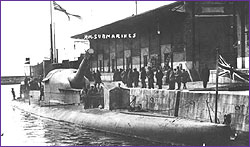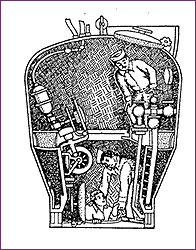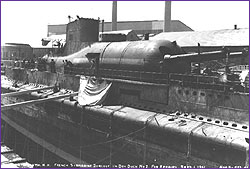 |

|
400 Years of Subs Introduction | 1580-1861 | 1861-1900 |1900-1918 1918-1939 | 1939-1945 | 1945-1972 | 1972-2000 1919 UC-97 became probably the only German submarine sunk within the continental United States. One of five U-boats turned over to the U.S. Navy for post-war study, she toured the Great Lakes as part of a Victory Bond drive, then was sunk (on purpose) in Lake Michigan a few miles east of Chicago. Post-war, the U.S. Navy began applying lessons learned, from operations and from a study of the captured U-boats, toward new submarine designs. Whereas the operating areas for the European powers were primarily close to home, the chief operating area for the U.S. Navy was the Pacific Ocean. Thus, the Navy needed a boat with good sea-keeping qualities, exceptional range, high reliability, and a reasonable level of habitability. 1919 Japan, emboldened by its surprise victory over the Russian colossus in 1905 and its successful role in providing escort services in World War I, began planning for an eventual showdown with the nation they viewed as their major and logical adversary: the United States. As one of the World War I allies, Japan received seven of the surrendered U-boats but went a bit beyond mere 'examination.' Japan imported some 800 German technicians, engineers, and naval officers to teach them how to design and build submarines.
The British converted several unfinished K-boats from steam to diesel power. They fitted one, designated M.1, with a 12-inch naval rifle. In theory, crew members could fire the gun while the boat was submerged; in practice, the submarine had to surface after each shot to reload the gun. M.1 sank after a collision in 1925. The British turned another, designated M.2, into a submarine aircraft carrier. M.2 sank when someone opened the hangar door by mistake while the boat was still partially submerged. 1919 The Treaty of Versailles blocked the German Navy from having submarines and limited the number of officers to 1,500. One of those officers was U-boat skipper Karl Dönitz. He was assigned as commanding officer of a torpedo boat—a submarine on the surface, if you will. He began developing submarine tactics for the next war. In secret, Germany acquired a Dutch shipbuilding company that designed submarines ostensibly for sale to international customers but that also were prototypes for the next class of German U-boats. In fact, it would be German crews that conducted sea trials in 1931 for three boats sold to the Finnish Navy.
Most major navies have tried to use submarines as aircraft carriers, though never with much success. The S-1, the 105th U.S. submarine, was equipped with an on-deck hangar and the Martin MS-1 seaplane. Wishful thinking: Crew had to disassemble the MS-1 to fit it in the hangar and had to reassemble it before flight, forcing the submarine to remain exposed for too long. In addition, launching and recovery proved virtually impossible in the open ocean. 1925 The British tested the 3,000-ton X.1, which came armed with four 5.2-inch guns and six 21-inch torpedo tubes. This was an attempt to build an underwater cruiser. It was not successful and was scrapped.
A steamer rammed the U.S. submarine S-51, which sank in 130 feet of water. Two years later, a Coast Guard cutter rammed S-4. Neither the Navy nor the Coast Guard had any means at their disposal to rescue survivors, and all hands were lost. These accidents led to the development of the McCann submarine rescue chamber, and an increase in the submarine hazardous duty pay instituted by Roosevelt in 1905.
Another Nautilus, the 168th American submarine, laid down in 1927, was another effort to put big guns on submarines—in this case, twin six-inch guns. Nautilus offered at least one improvement over the British and French efforts—gunners could train and aim the guns independently—but the shells were too heavy for safe handling, and the V-class boat proved too cumbersome for operations as an attack submarine. The Navy converted Nautilus into a seaplane filling station and amphibious support ship for World War II.
Not to be outdone by the British or Americans, France fielded Surcouf, at 361 feet and 3,304 tons the world's largest submarine until World War II. Armed with twin 8-inch guns and an airplane, Surcouf disappeared in 1942, probably after a collision with a merchantman. 1932 The U.S. Navy opened a competition for the development of a lightweight diesel engine more suitable to submarines than any currently in production. While the number of engines that the Navy might purchase for submarines was too small to justify the investment, engine manufacturers understood that a large commercial market waited in the wings: the railroad. 1932 Japanese submarine designers moved out from under the shadow of the Germans and, on their own, focused on three basic classes: the I-boats, most of them about the size of the German U-cruisers; the RO coastal boats, roughly the size of the German Type VII (see 1935) but not as capable; and the HA series of midget submarines, in many variations. The Japanese were more serious about submarine aircraft carriers than any other navy: They built their first, the 2,243-ton, 320-foot I-5, in 1932. It was equipped with one floatplane. In the next 12 years, they built 28 more, in ever-increasing sizes. 1932 The German government approved the clandestine construction of 16 new U-boats.
On March 16, German Chancellor Adolf Hitler renounced the Treaty of Versailles. A few weeks later, the first of a new series of U-boat, U-1, entered service. 1935 Captain Dönitz defined his fundamental concepts for the next conflict: "Tonnage War" and "Wolf Pack." The first replicated World War I experience: Sink ships faster than they can be replaced, for a long enough period, and you could strangle an island nation like Britain. The second: Teams of seven or eight boats attack on the surface at night, submerge to escape, resurface and speed ahead to get in position for the next night's attack. The U-boats' 15-knot surface speed was almost twice that of an average convoy and equal to that of most anti-submarine escorts.
1938 An experimental 140-foot, 213-ton Japanese HA boat topped 21 knots—submerged. The Japanese also developed the world's most effective torpedo, the Long Lance. The MK95 submarine version had a 900-pound warhead, a wakeless oxygen-fueled turbine, and a range of five miles at 49 knots. Contemporary U.S. Navy torpedoes had half the warhead and half the range—when they were working (see 1941, torpedo 'design' issues). Continue: 1939-1945 Tour U-869 | Sole Survivor | Hazards of Diving Deep 400 Years of Subs | Map of Lost U-Boats | Fire a Torpedo Resources | Transcript | Site Map | Hitler's Lost Sub Home Editor's Picks | Previous Sites | Join Us/E-mail | TV/Web Schedule About NOVA | Teachers | Site Map | Shop | Jobs | Search | To print PBS Online | NOVA Online | WGBH © | Updated November 2000 |






